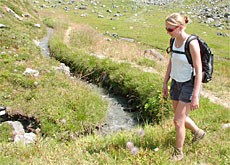
Discovering the ancient waterways of Valais

Hiking along ancient irrigation channels in canton Valais shows how people have made use of scarce water resources over the centuries.
The canals are a unique attraction even though they no longer serve their original purpose – and one of the best known is the Bisse du Levron in the Val de Bagnes.
At first glance, the Bisse du Levron is anything but impressive. It is not very wide – about a metre – nor is the water it transports fast flowing.
Yet the true dimensions of the canal and its former importance become apparent after following its course for a couple of hours.
The irrigation channel diverts water from a mountain stream to the village of Levron 25 kilometres away, and has been doing so for more than 500 years now.
As we discover, it crosses alpine meadows and forests, passes above the large ski resort of Verbier, and spills through a gorge before making a final turn towards the fields of Levron.
The canal has long since become redundant for the people of Levron who now use a modern sprinkler system to water their fields.
Preservation
Yet our guide, Sonia Tissières, says she is glad that the Bisse du Levron and other ancient channels in canton Valais have been preserved or are in the process of being restored.
The Bisse du Levron is one of nearly 200 old irrigation channels which still exist in canton Valais and cover a total distance of about 750 kilometres. There are hiking trails along half of them.
“We need to understand how our ancestors lived and the irrigation channels are unique to this region,” Tissières explains.
She goes on to tell us that for a long time the Bisse du Levron was not only the source of wealth but also feuds between the villages of the Val de Bagnes.
In the middle of the 15th century, Levron applied to the abbot to harness the waters stemming from the Tortin Glacier.
Sabotage
The request was eventually approved, much to the dismay of the villagers living in the communities directly below the mountain stream, who did not want to see the precious commodity diverted.
They sabotaged the canal and it took decades for the feuds to die down.
The Bisse du Levron in its current form dates from 1484. It is no longer targeted by angry villagers but by mischievous children and adults.
“It’s my job to remove all the rocks thrown in by boys, and even adults who should really know better and act their age,” says a man we come across who claims to be the current guardian of the Bisse du Levron.
As explained on the information boards set up along the trail, it was historically the guardian’s job to carry out regular inspections of the canal, do repairs and ensure that people adhered to the complex rules governing its control, use and maintenance.
Serpentine stream
Before it’s diverted into the canal, the mountain stream which is its source serpentines through a lush peat bog.
The bog is a green oasis surrounded by mountain slopes that are scarred by cable car masts and the dirt access roads of the giant Verbier ski area.
Standing here we realize how much people holidaying in a major alpine resort take water for granted.
The tens of thousands of tourists who now descend on the Val de Bagnes each year, mostly to spend a few days in Verbier, expect water on demand – for drinking, showering and cooking, as well as for the production of artificial snow in winter.
Manmade reservoir
Verbier relies on a large reservoir for its supply since it could never quench its huge thirst if it had to tap into the canal.
We decide to seek out the manmade lake, since our guide tells us it is hidden behind a ridge in a largely unspoilt region, about a three-hour walk from the peat bog.
The mountainsides above Verbier may be built up, but half of the Val de Bagnes’ 300 square kilometres are protected as part of a nature reserve.
It is not long before we are accompanied on our hike by the constant shrill whistles of marmots, and before we make our first of many sightings of ibex and chamois.
As we start our descent to the lake, we are pleased to discover that its appearance does little to disturb the raw beauty of the mountain landscape.
We are also surprised to come across a couple of men at work practising the nearly forgotten skills of erecting dry stonewalls.
They tell us that they have been hired to restore a small grouping of ancient stone and earth cowsheds and shepherds’ huts.
The structures, as the men explain, are as important to the heritage of the Val de Bagnes as the many irrigation channels.
swissinfo, Dale Bechtel in the Val de Bagnes
Canton Valais has preserved a network of nearly 200 ancient irrigation channels, covering a distance of about 750 kilometres.
The channels are known as “bisses” in French-speaking Valais and “Suonen” in German-speaking parts of the canton.
There are 23 communities in the Val de Bagnes, with the alpine resort of Verbier being the best known.
The valley covers a 300 square kilometre area, and half of it is a protected nature reserve.
Hiking trails throughout the Val de Bagnes are well marked, but guides can also be hired who are well versed in the region’s cultural heritage and its flora and fauna.

In compliance with the JTI standards
More: SWI swissinfo.ch certified by the Journalism Trust Initiative































You can find an overview of ongoing debates with our journalists here . Please join us!
If you want to start a conversation about a topic raised in this article or want to report factual errors, email us at english@swissinfo.ch.